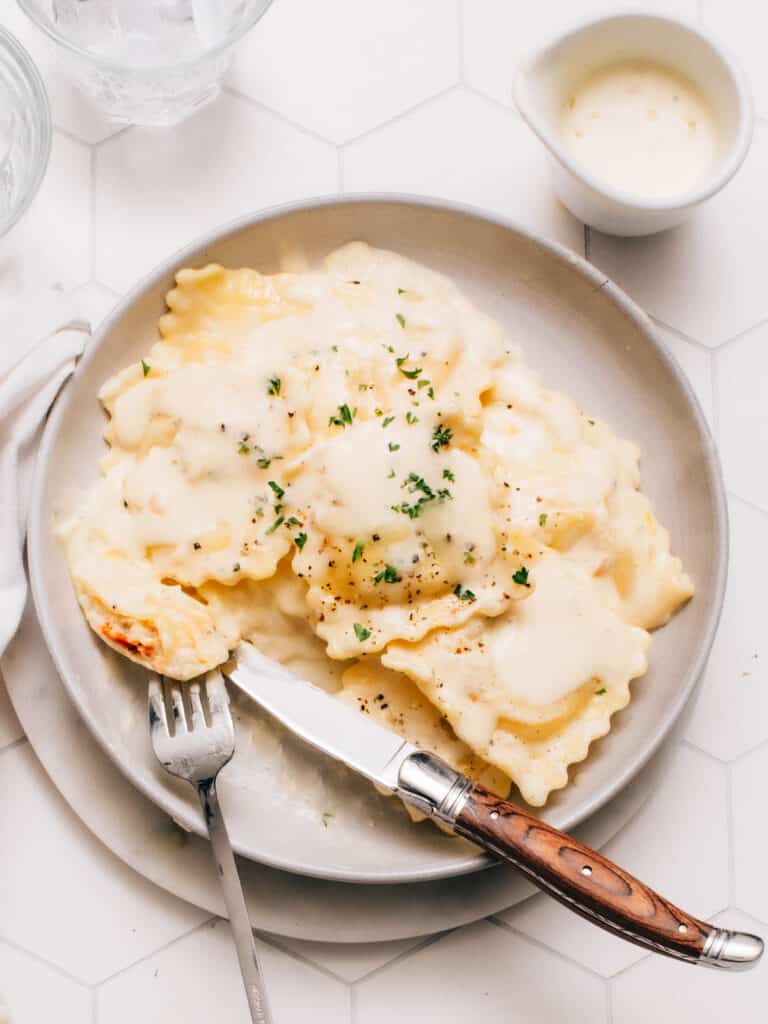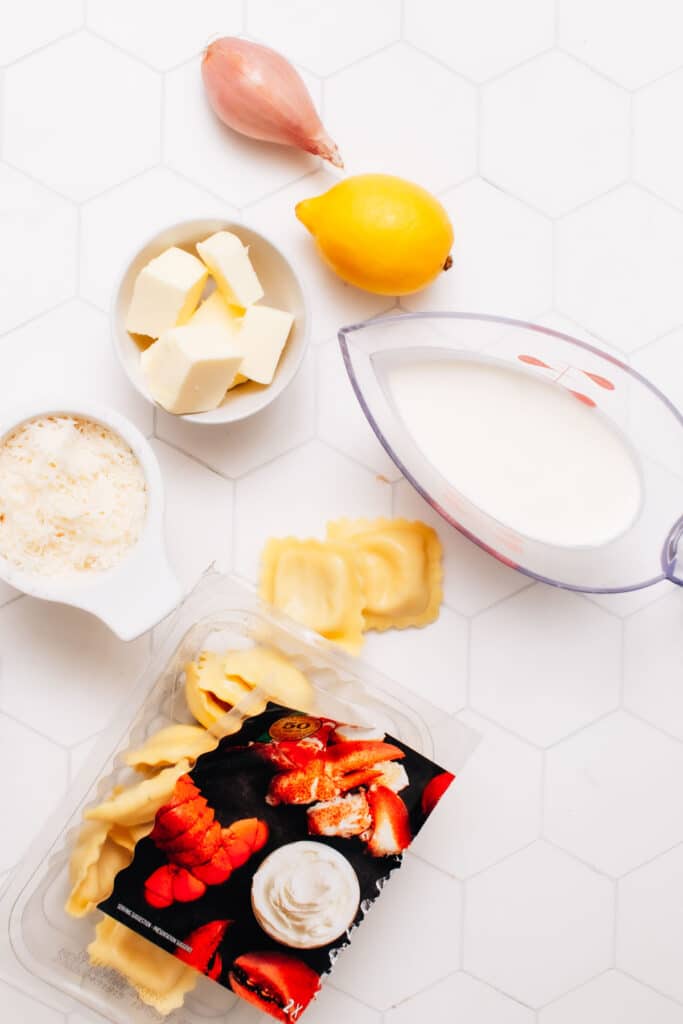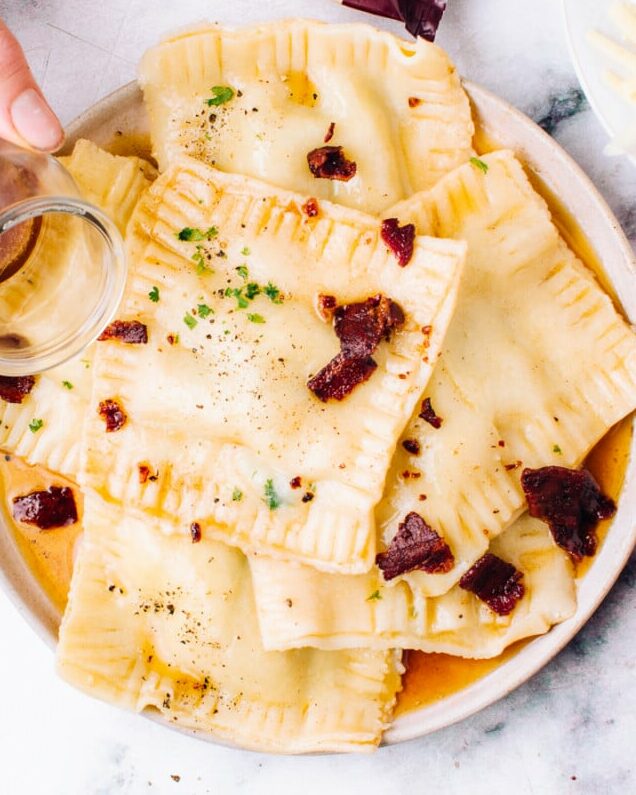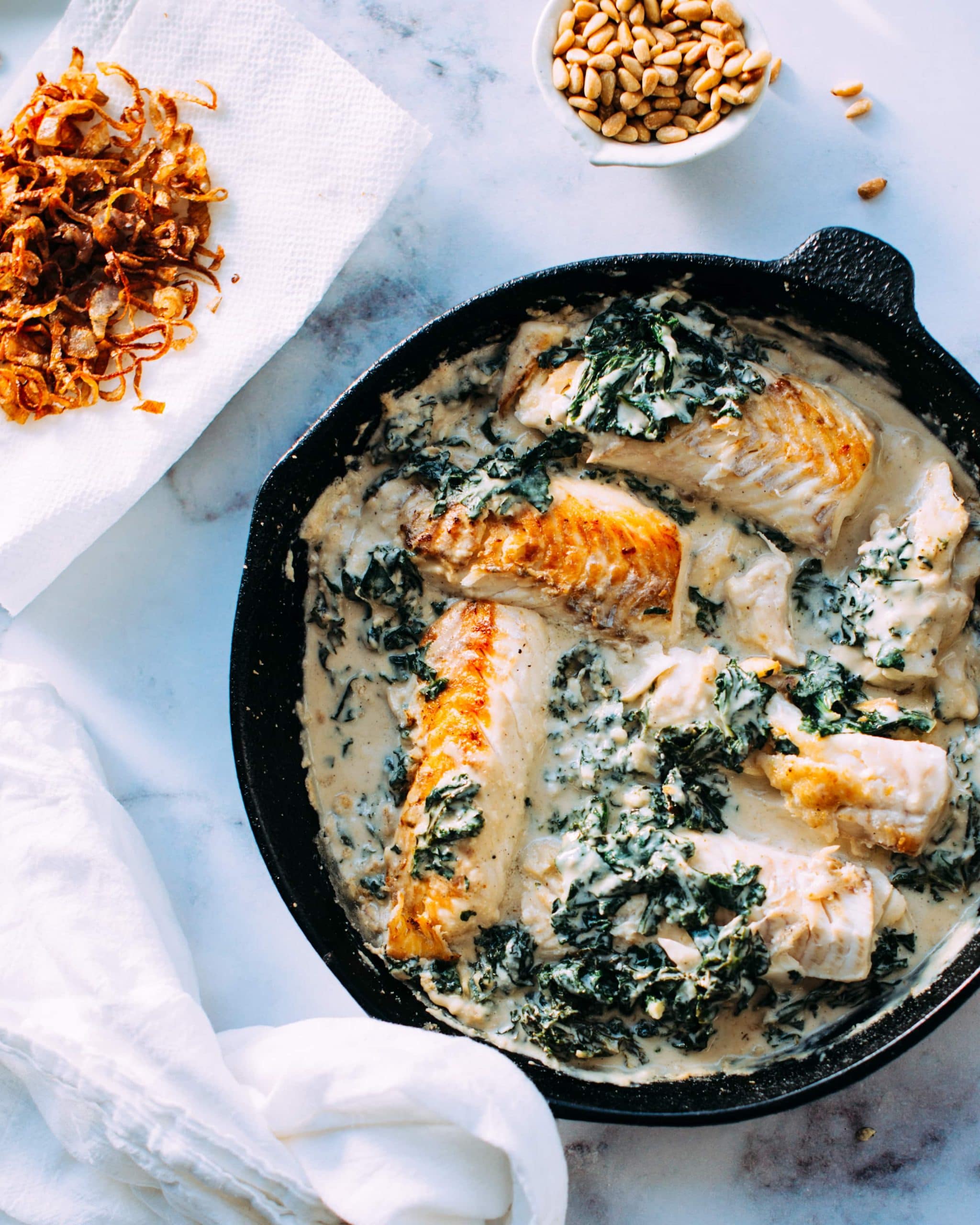How Long To Cook Fresh Ravioli (For Perfect Results Every Time!)
Feb 28, 2024, Updated Apr 01, 2024
Here is everything you need to know about how long to cook fresh ravioli, plus how to cook it to perfection every time.

As simple as these little pasta pockets look, cooking them can present a few challenges. Follow these tried-and-tested tips to get them right the first time.
If you’d like to make ravioli from scratch, try my cozy recipe for Butternut squash + mascarpone ravioli with hazelnut brown butter.
For a store-bought ravioli, a more convenient recipe (one that is, like, restaurant-quality good), here’s my lobster ravioli with a creamy, lemony pasta sauce.
You will LOVE the flavor result.

How Is Ravioli Cooked?
The most common way to cook ravioli (and how I’ve based this article) is to cook it in boiling salted water.
Ravioli are sometimes boiled or poached in broth or in a cream or marinara sauce. They can also be steamed, pan-fried, or cooked in a ravioli bake or large skillet.
How Long To Boil Fresh Ravioli For?
Fresh ravioli typically boils for 4 to 5 mins until tender and cooked through. The exact time may vary, however, depending on the size and thickness of the ravioli.
It’s key to follow the instructions on the package and watch the ravioli while it cooks. You want to prevent it from overcooking and turning mushy.
How Do I Know When Ravioli Is Done?
You can tell when ravioli is done cooking by checking its texture and appearance:
- Texture: The ravioli should be tender but still have a slight firmness to it. You don’t want it overly soft.
- Appearance: Ravioli floats to the surface of the boiling water when it is done. This is your sign that it is cooked. However, you should definitely taste a piece to make sure it’s cooked. Take care not to burn when fishing it out and eating your test piece – I recommend using a slotted spoon for safety.
If you’re cooking stuffed ravioli, you can check if the filling inside is hot and cooked through by cutting it into one piece or testing it with a fork.
If the filling is heated through, the ravioli is likely done. Always read the cooking instructions on the packaging (if you’re using store-bought fresh ravioli).

Tips To Prevent Ravioli Breaking
To prevent ravioli from breaking during the cooking process, check out my top tips:
- Avoid overstuffing: This is number one on the list! Leave enough space around the edges to seal them properly without straining the dough.
- Handle gently: Ravioli, especially fresh ones, can be delicate. Handle your little babies gently when transferring them into boiling water or when stirring them during cooking.
- Seal properly: Ensure that you seal the edges of the ravioli properly, pressing firmly to eliminate any air bubbles or pockets that can weaken the structure of the pasta.
- Use fresh pasta: Fresh pasta tends to be more pliable and less prone to breaking than dried pasta. If possible, use fresh ravioli for cooking.
- Boil gently: When boiling ravioli, use a gentle boil rather than a vigorous one. Rapid boiling water can cause the pasta to bump into each other or against the pot’s surface, and break.
- Use lots of water: Use a large pot (even if it seems way to big) with plenty of water to boil the ravioli. Crowding them in a small pot can cause them to stick together and break. Remember to add plenty of salt to the cooking water.
- Check doneness early: Keep an eye on the ravioli while they cook. I recommend checking for doneness a minute or so before the recommended cooking time. This is a great way to prevent overcooking them.
These tips will help lower the risk of ravioli breaking during the cooking process.
How To Stop Ravioli From Sticking
Pasta dough is made with eggs and flour – these ingredients can lead to “sticking” when cooked. To prevent ravioli from sticking together during cooking, follow these tips:
- Use lots of water in a large pot: This ensures that they have enough space to move around freely without sticking together.
- Stir gently: Once you add the ravioli to the boiling water, gently stir them with a spatula to prevent them from sticking to the bottom of the pot or to each other.
- Boil gently, not rapidly: Rapid boiling can cause the ravioli to bump into each other, increasing the chances of sticking.
- Use fresh pasta: Fresh ravioli tend to be less prone to sticking than dried ravioli. If you’re making homemade ravioli, try this fresh pasta dough.
- Avoid overcrowding: Cook the ravioli in batches if necessary to prevent overcrowding and subsequent sticking.
- Remove quickly: Avoid letting them sit in the hot water for too long, as this leads to sticking. Use a slotted spoon to scoop them into a colander or dish. At this point, tossing them in a splash of olive oil can help prevent sticking as they cool.
By following these tips, you can help prevent ravioli from sticking together during the cooking process.

FAQS
Just skimming through? Here is a roundup of key takeaways from this article:
How long should I boil fresh ravioli?
Fresh ravioli typically cook quickly. Boil them in salted water for about 4 to 5 minutes, or until they float to the surface and are tender but still firm to the bite. Be cautious not to overcook.
Is ravioli done when it floats?
Floating ravioli could be partially cooked, so it’s important to check its texture by tasting to ensure it’s tender yet still slightly firm to the bite.
Does the cooking time vary based on the filling?
The cooking time for fresh ravioli generally remains consistent regardless of the filling. However, if the ravioli is particularly large or has a thicker dough, it may require an extra minute or so to cook through thoroughly.
Can I cook fresh ravioli in advance?
Yes, you can cook fresh ravioli in advance and store it in the refrigerator for a short period. Ensure the cooked ravioli are cooled entirely before transferring them to an airtight container (in a single layer).
When ready to serve, reheat them gently by dipping them in hot water for a few seconds or tossing them in a warm sauce.
How do I prevent fresh ravioli from becoming soggy?
Avoid overcooking fresh ravioli to prevent them from becoming soggy. Once they float to the surface and are tender yet firm to the bite, quickly remove them from the boiling water.
Shocking them in cold water can also stop the cooking and help retain their texture.
Is there a difference in cooking time between fresh and dried ravioli?
Yes, fresh ravioli generally cooks faster than dried ravioli. Dried ravioli may take a few extra minutes to cook through as they need to rehydrate during the boiling process.
Follow the instructions on the package for dried ravioli and adjust the cooking time accordingly.
Can I use the same boiling water for multiple batches of ravioli?
Yes, you can reuse the same boiling water to cook multiple ravioli batches. However, ensure the water is still at a rolling boil before adding each batch.
Adding a splash of fresh water and adjusting the heat as needed can help maintain the boiling temperature.
How long is al dente for ravioli?
Generally, fresh ravioli cooked al dente will take about 4 to 5 minutes in boiling water. When you bite into it, it should still have a slight firmness without feeling undercooked or too hard.
How do you know if fresh pasta is cooked?
Fresh pasta usually floats to the surface when it is cooked. It has a firm texture, too.
How long should I cook frozen ravioli for?
You should cook frozen ravioli for roughly 4-6 minutes. The boiling time can vary based on the thickness and size of your ravioli.
Can the type of ravioli filling affect the total cooking time?
Yes, the type of filling ingredients used in the ravioli can impact the cooking time. Ravioli recipes with denser fillings like ground beef may require slightly longer cooking times compared to ravioli with lighter fillings like ricotta cheese or spinach.
Next Reading: How to Make Pasta From Scratch
Pasta Sauces You’ll Love
- Lazy Lasagna (made with fresh ravioli and jarred tomato sauce – seriously so good!)
- Lobster Ravioli Sauce
- Seafood Pasta with Cream Sauce
- Beet Pasta Sauce
- The Best Meat Sauce
- Asiago Tortelloni Alfredo with Grilled Chicken
- Mushroom Pappardelle

How Long to Cook Fresh Ravioli (For Perfect Results Every Time!)
Ingredients
- 4 quarts water
- 2 tbsp kosher salt
- 1 lb fresh ravioli
Instructions
- Bring 4 quarts of water to a rolling boil in a large pot. Stir in 2 tbsp of kosher salt into the boiling water.
- Gently add 1 lb of fresh ravioli to the pot. Boil the ravioli for 4 to 5 mins, watching carefully to prevent overcooking.
- Ravioli are ready when they float to the top and feel tender yet firm to the touch. Test one ravioli with a slotted spoon for doneness, ensuring the filling is hot if they're stuffed. Adjust boiling time as needed based on the ravioli's size and thickness.
Notes
Nutrition
Nutrition information is automatically calculated, so should only be used as an approximation.













Perfect thanks.
This information is so helpful! Thanks Jennifer
I always struggle to tell when fresh ravioli are cooked through. Thanks for those visual cues
Thanks for this Jenn! I always seem to overcook them
This is a helpful guide for someone like me who struggles with cooking fresh ravioli perfectly. No more mushy pasta!
I love experimenting with different flavors. Do you think I could use flavored ravioli, like spinach and ricotta, with this cooking method?
Yes, absolutely! Just keep in mind that thicker stuffed ravioli may need a bit more time.